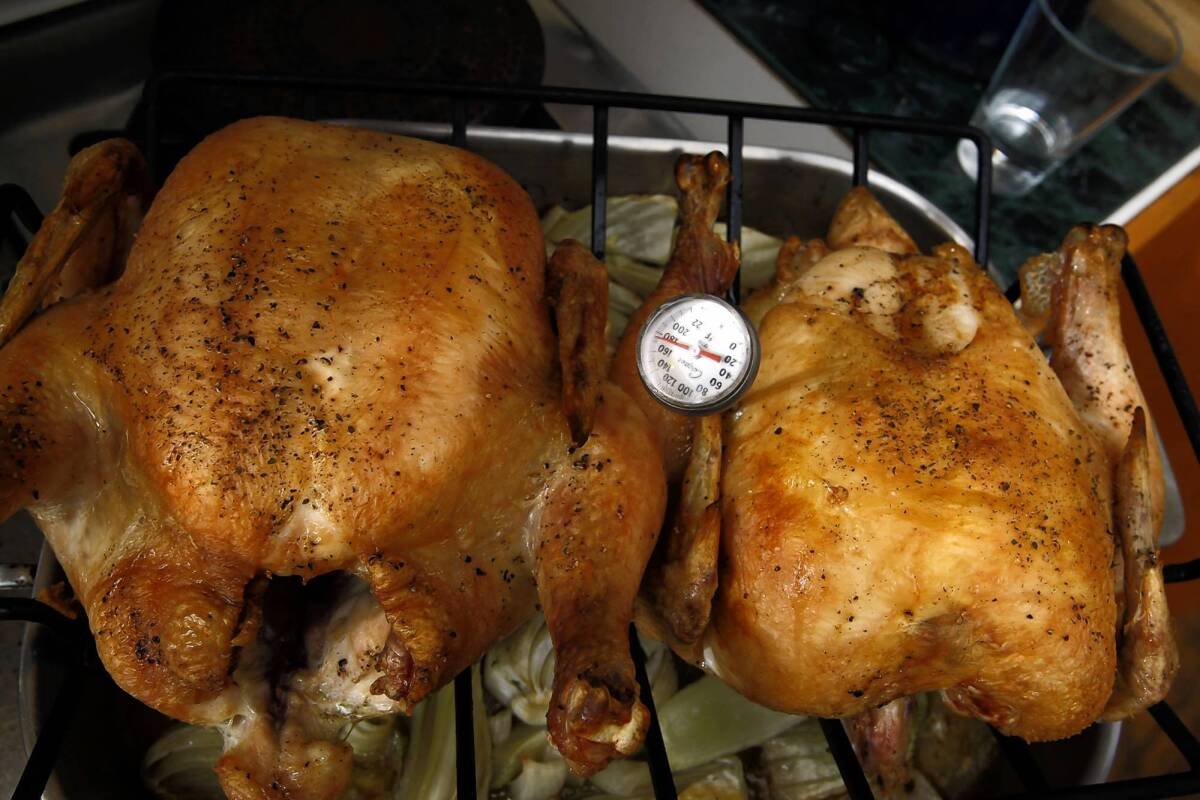A cozy cooking class for beginners

- Share via
If you’d like to try our cooking class at your own home, here’s an outline of how to go about it. Of course, feel free to improvise.
Roast Chicken: Remove the chicken from the refrigerator at least 30 minutes before roasting. Rinse it well and pat it thoroughly dry. Sprinkle with salt (about 1 tablespoon for every 5 pounds of weight), and rub it with softened butter (about 1 tablespoon). Season generously with freshly ground black pepper. Place the chicken in a roasting pan or cast-iron skillet and scatter wedges of fennel and onion around it. Roast in a 400-degree oven. After about 50 minutes, insert an instant-read thermometer into the deepest part of the thigh; the chicken will be done when it reads 165 degrees. Remove from the oven, cover lightly with a sheet of aluminum foil and let stand at room temperature for 10 minutes before carving.
Questions: How did the color of the chicken change? How did the texture of the skin change? Try inserting the thermometer when the chicken is raw, and then again when it is cooked; do you notice a difference in texture? Taste the fennel before and after cooking, how has it changed? Cut some of the onion or fennel into smaller pieces before cooking; how is the texture and flavor different?
Options: Scatter different vegetables around the pan under the chicken: Try onions, fennel, potatoes, parsnips, carrots and turnips, alone or in combination. Season the chicken with different herbs and spices: Try chopped rosemary, thyme and tarragon or ground cumin, herbes de Provence or paprika.
Pasta with broccoli rabe: Bring a large pot of water to a boil. Salt it generously (the water should be about as salty as sea water). Add dried pasta (21/2 ounces per person for a first course; 3 ounces for a main course). Heat a large sauté pan over medium-high heat and add enough olive oil to generously coat the bottom (2 to 3 tablespoons). Add two whole, peeled garlic cloves and a pinch of dried red pepper flakes and cook, stirring occasionally. You want the garlic to turn golden but not scorch; if it’s cooking too quickly, reduce the heat slightly. Chop the stems of the broccoli rabe and, after the pasta has been cooking for 3 to 4 minutes, add the stems to the boiling water. After another minute or two, add the tops. When the pasta is tender but not soft, scoop out the noodles and the cooked broccoli rabe and add them to the sauté pan with the garlic and olive oil. Ladle about 3 to 4 tablespoons of the cooking water into the pan and increase the heat to high. Cook, stirring constantly, until the pasta water has evaporated, about 2 to 3 minutes. Drizzle with a little fresh olive oil and season to taste with more salt. Divide the cooked pasta and greens evenly among the serving plates and use a vegetable peeler to shave thin sheets of Parmesan over top.
Questions: Why do you add the greens in two stages? What difference would it make to use sliced garlic instead of whole? Taste the pasta after it’s been added to the hot oil, and then after the added cooking water has boiled off; do you see the difference? Toss with grated Parmesan instead of topping with shaved; how does that change the dish?
Options: Try using different pasta shapes. Try different vegetables — broccoli instead of broccolini (peel and dice the thick stalks), cauliflower or even sturdy cooking greens such as kale (chop into bite-sized pieces and cook only for the last 3 or 4 minutes). For the seasoning mixture in the sauté pan, add chopped green olives and/or drained capers to the garlic. Brown crumbled Italian sausage or cubed pancetta. Add shredded cooked meat or slivered prosciutto after the cooking. Top with pecorino Romano instead of Parmesan.
Green salad: Rub a cut clove of garlic around the inside of a serving bowl. Fill the bowl with mixed lettuce greens and toss lightly. Prepare the dressing by adding sherry vinegar to olive oil, whisking constantly, until you have the flavor balance you want. Sprinkle with salt and whisk again. Add the dressing to the salad, a tablespoon at a time, tossing with your hands until the lettuces feel lightly coated with oil. Season with salt to taste and toss gently. Serve immediately.
Questions: Compare the tastes and textures of the different types of lettuce. In the vinaigrette, what is the ratio of oil to vinegar you like best? Does it make a difference when you taste with a bitter lettuce rather than a soft one? Try making the dressing with different kinds of vinegars or lemon or lime juices and see how that changes the flavor. How does the flavor of the dressing change after you add the salt? Add a spoonful of Dijon mustard to the vinaigrette and whisk it in thoroughly to make a smooth mixture; how does this change the texture? Leave a couple of pieces of lettuce behind in the bowl and taste them after five minutes; how have they changed?
Options: Try different mixes of lettuces. Add cooked vegetables or shredded or cubed cooked meat. Top with fruit, nuts or cheese. Vary the dressing by using different kinds of oils, vinegars and lemon or lime juice. Instead of rubbing the bowl with a cut clove of garlic, add minced garlic or shallot to the dressing (let it sit with the vinegar for a few minutes before mixing). Add minced fresh herbs such as tarragon, chervil and parsley to the vinaigrette, or ground spices such as cumin, fennel seed or dried red pepper flakes.
More to Read
Eat your way across L.A.
Get our weekly Tasting Notes newsletter for reviews, news and more.
You may occasionally receive promotional content from the Los Angeles Times.











